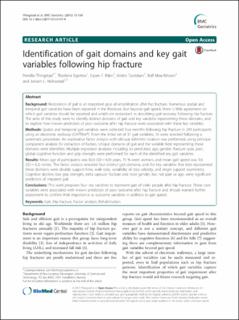Identification of gait domains and key gait variables following hip fracture
Thingstad, Pernille; Egerton, Thorlene; Ihlen, Espen Alexander F.; Taraldsen, Kristin; Moe-Nilssen, Rolf; Helbostad, Jorunn L.
Peer reviewed, Journal article
Published version

Åpne
Permanent lenke
https://hdl.handle.net/11250/2657802Utgivelsesdato
2015Metadata
Vis full innførselSamlinger
Sammendrag
Background:Restoration of gait is an important goal of rehabilitation after hip fracture. Numerous spatial andtemporal gait variables have been reported in the literature, but beyond gait speed, there is little agreement onwhich gait variables should be reported and which are redundant in describing gait recovery following hip fracture.The aims of this study were to identify distinct domains of gait and key variables representing these domains, andto explore how known predictors of poor outcome after hip fracture were associated with these key variables.Methods:Spatial and temporal gait variables were collected four months following hip fracture in 249 participantsusing an electronic walkway (GAITRite®). From the initial set of 31 gait variables, 16 were selected following asystematic procedure. An explorative factor analysis with oblique (oblimin) rotation was performed, using principalcomponent analysis for extraction of factors. Unique domains of gait and the variable best representing thesedomains were identified. Multiple regression analyses including six predictors; age, gender, fracture type, pain,global cognitive function and grip strength were performed for each of the identified key gait variables.Results:Mean age of participants was 82.6 (SD = 6.0) years, 75 % were women, and mean gait speed was 0.6(SD = 0.2) m/sec. The factor analysis revealed four distinct gait domains, and the key variables that best representedthese domains were double support time, walk ratio, variability of step velocity, and single support asymmetry.Cognitive decline, low grip strength, extra capsular fracture and male gender, but not pain or age, were significantpredictors of impaired gait.Conclusions:This work proposes four key variables to represent gait of older people after hip fracture. These corevariables were associated with known predictors of poor outcome after hip fracture and should warrant furtherassessment to confirm their importance as outcome variables in addition to gait speed.
